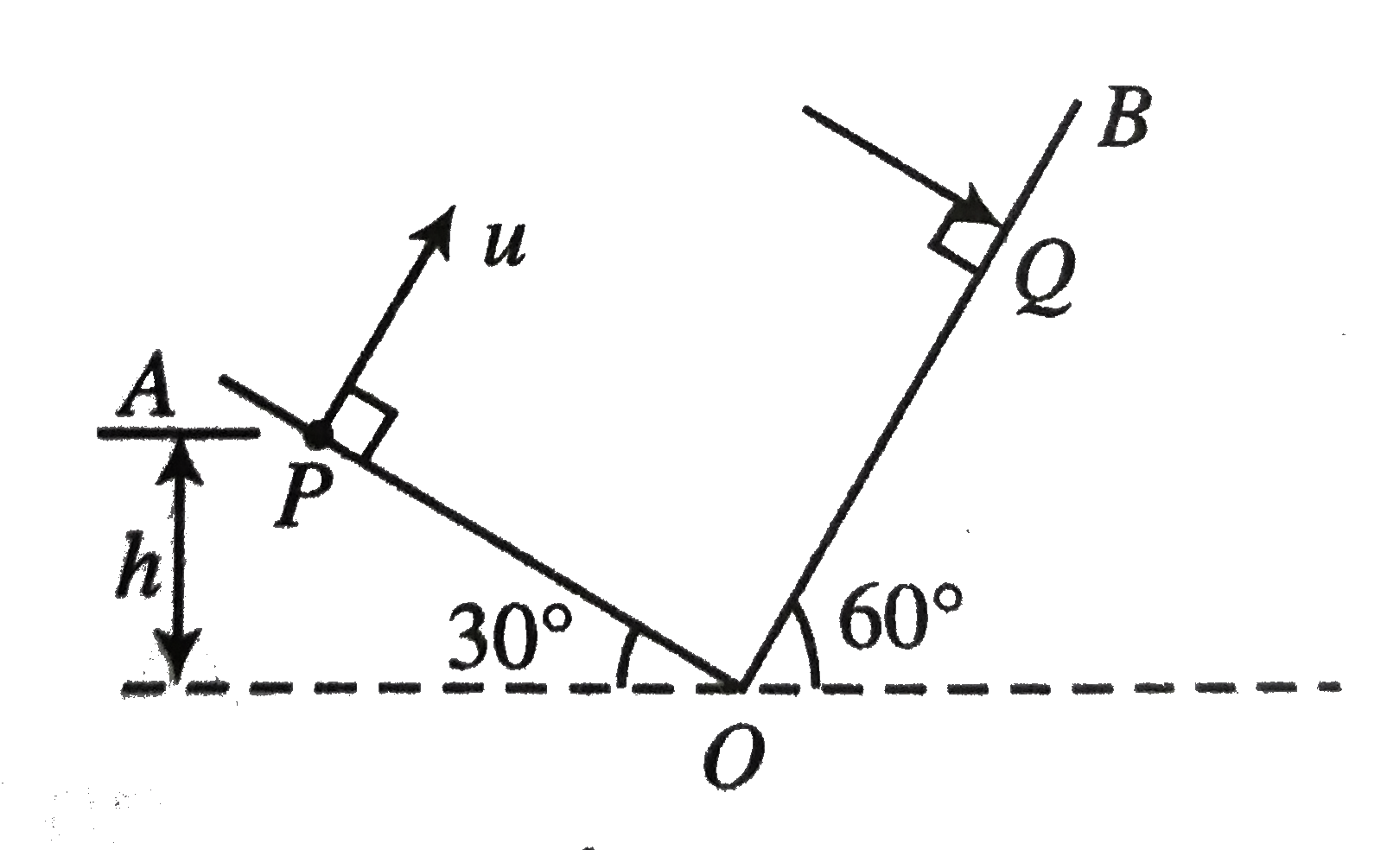Two inclined planes OA and OB having inclination (with horizontal) 30∘and60∘, respectively, intersect each other at O as shown in figure. A particle is projected from point P with velocity u=10√3ms−1 along a direction perpendicular to plane OA. If the particle strikes plane OB perpendicularly at Q, calculate

The vertical height h of P from O,
10 m
5 m
15 m
20 m
The correct Answer is:B
b. Two given planes are mutually perpendicular and the particle
is projected perpendicularly from plane OA. It means →u is
parallel to plane OB.
At the instant of collision of the particle with OB, its velocity
is perpendicular to OB or velocity component parallel to OB
is zero.
First considering motion of particle parallel to plane OB,
u=10√3ms−1,
Acceleration =−gsin60∘=−5√3ms−2
v=0,t=?s=?
Using v=u+at⇒0=10√3−5√3t⇒t=2s.
s=ut+12at2⇒OQ=10(√3)×2−125√3(2)2
⇒OQ=10√3m.
Now considering motion of the particle normal to plane OB.
Initial, velocity = 0, acceleration =gcos60∘=5ms−2
t=2s,v=?s=PQ=?
Using v=u+at,we≥tv=10ms−1
s=it+12at2orPO=10m
h=POsin30∘=10×sin30∘=5,
Inclination of velocity at point P with the vertical is 30∘.
therefore its vertical component is ,
ucos30∘=15ms−1 (upwards)
Considering vertically upward motion of the particle from P.
Initial velocity =15ms−1,
Acceleration =−g=−10ms−2,v=0,s=H=?
Using v2=u2+2as, we get H=11.25m
Maximum height reached by particle above O is
h + H = 16.25m
Distance PQ=√(PO)2+(OQ)2=√(102)+(10√3)2=20m .
Topper's Solved these Questions
- MISCELLANEOUS KINEMATICSBOOK - CENGAGE PHYSICSCHAPTER - MISCELLANEOUS KINEMATICSEXERCISE - Integer Type
17 Videos
- MISCELLANEOUS KINEMATICSBOOK - CENGAGE PHYSICSCHAPTER - MISCELLANEOUS KINEMATICSEXERCISE - Fill in the blanks
4 Videos
- MISCELLANEOUS KINEMATICSBOOK - CENGAGE PHYSICSCHAPTER - MISCELLANEOUS KINEMATICSEXERCISE - Multiple Correct Answer Type
26 Videos
- LINEAR AND ANGULAR SIMPLE HARMONIC MOTIONBOOK - CENGAGE PHYSICSCHAPTER - LINEAR AND ANGULAR SIMPLE HARMONIC MOTIONEXERCISE - Multiple Correct Answer Type
9 Videos
- MISCELLANEOUS VOLUME 2BOOK - CENGAGE PHYSICSCHAPTER - MISCELLANEOUS VOLUME 2EXERCISE - INTEGER_TYPE
10 Videos
Similar Questions
Two inclined planes OA and OB having inclinations 30∘ and 60∘ with the horizontal respectively intersect each other at O, as shown in figure. A particle is projected from point P with velocity u=10√3m/s along a direction perpendicular to plane OA. If the particle strikes plane OB perpendicular at Q. Calculate.

(a) time of flight,
(b) velocity with which the particle strikes the plane OB,
(c) height h of point P from point O,
(d) distance PQ. (Take g=10m/s2)
View SolutionTwo inclined planes OA and OB having inclination (with horizontal) 30∘ and 60∘(), respectively, intersect each other at O as shown in figure. A particle is projected from point P with velocity u=10√3ms−1 along a direction perpendicular to plane OA. If the particle strikes plane OB perpendicularly at Q, calculate

The maximum height attained by the particle (from the line O)
View Solution
Knowledge Check
Two inclined planes OA and OB having inclination (with horizontal) 30∘ and 60∘, respectively, intersect each other at O as shown in figure. A particle is projected from point P with velocity u=10(√3)ms−1 along a direction perpendicular to plane OA. If the particle strikes plane OB perpendicularly at Q, calculate

The distance PQ,A20 mB10 mC5 mD2.5 mTwo inclined planes OA and OB having inclination (with horizontal) 30∘ and 60∘, respectively, intersect each other at O as shown in figure. A particle is projected from point P with velocity u=10(√3)ms−1 along a direction perpendicular to plane OA. If the particle strikes plane OB perpendicularly at Q, calculate

Time of flight of the particlesA8 sB6 sC4 sD2 sTwo inclined planes OA and OB having inclination (with horizontal) 30∘ and 60∘, respectively, intersect each other at O as shown in figure. A particle is projected from point P with velocity u=10(√3)ms−1 along a direction perpendicular to plane OA. If the particle strikes plane OB perpendicularly at Q, calculate

The velocity with which particle strikes the plane OB,A15ms−1B30ms−1C20ms−1D10ms−1
Two inclined planes OA and OB having inclination (with horizontal) 30∘ and 60∘ respectively , intersect each other at O. A particle is projected from point 'P' with velocity u=10√3 m/s along a direction perpendicu lar to plane OA. If the particle strikes plane OB perpendicu lar at Q. Calcu late:

Time of flight of the particle:
View SolutionTwo inclined planes OA and OB having inclination (with horizontal) 30∘ and 60∘ respectively , intersect each other at O. A particle is projected from point 'P' with velocity u=10√3 m/s along a direction perpendicu lar to plane OA. If the particle strikes plane OB perpendicu lar at Q. Calcu late:

The velocity with which particle strikes the plane OB.
View SolutionTwo inclined planes (I) and (II) have inclination alpha and beta respectively with horizontal (where α+β=90∘)intersect each other at point O as shown in figure A particle is projected from point A with velocity u along a direction perpendicular to plane (I) If the particle strikes (II) perpendicularly at B, then:

View SolutionTwo inclined planes OA and OB intersect in a horizontal plane having their inclinations αandβ with the horizontal as shown in figure. A particle is projected from P with velocity u along a direction perpendicular to plane OA. The particle strikes plane OB perpendicularly at Q.

The path of the particle from P to Q is
View SolutionTwo inclined planes OA and OB intersect in a horizontal plane having their inclinations αandβ with the horizontal as shown in figure. A particle is projected from P with velocity u along a direction perpendicular to plane OA. The particle strikes plane OB perpendicularly at Q.

If α=30∘,β=30∘ the time of flight from P to Q is
View Solution
